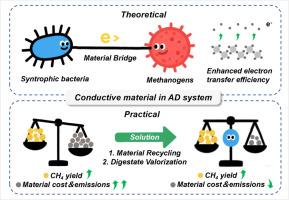导电性材料在厌氧消化中的应用:可持续发展的途径还是隐藏的碳负担?
IF 12.4
1区 环境科学与生态学
Q1 ENGINEERING, ENVIRONMENTAL
引用次数: 0
摘要
导电性材料介导的厌氧消化(AD)系统为提高甲烷产量提供了一个很有前途的解决方案,但其可持续性和经济可行性需要全面评估。在本研究中,我们通过219个实验案例的综合生命周期和成本效益分析,系统评估了典型的导电材料,即生物炭、铁基材料和生物炭-铁复合材料。生物炭-铁复合材料实现了最高的甲烷产量提高(36%),而铁基材料带来了显著的碳负担(占系统排放量的44%)。至关重要的是,材料回收(五个循环)将铁的碳足迹减少了72%,而消化物转化为生物炭进一步降低了113.8% -184.9%的净排放量。经济上,铁基材料的盈利能力优于生物炭(220美元/吨挥发性固体(VS)),将材料回收与消化物增值相结合,净利润提高了191.8-264.8%。研究结果表明,优先考虑生物炭-铁复合材料的性能和铁基材料的回收成本效益,以及闭环设计,可以协调环境和经济目标。这项工作为优化导电材料增强型AD系统提供了可行的途径,以实现可扩展、可持续的废物转化为能源。本文章由计算机程序翻译,如有差异,请以英文原文为准。

Making Waves: Conductive Materials in Anaerobic Digestion: A Sustainable Pathway or a Hidden Carbon Burden?
Conductive material-mediated anaerobic digestion (AD) systems offer a promising solution to enhance methane production, yet its sustainability and economic viability require holistic evaluation. In this study, we systematically assess the typical conductive materials, namely, biochar, iron-based material, and biochar-iron composites, through integrated life cycle and cost-benefit analyses of 219 experimental cases. Biochar-iron composites achieved the highest methane yield improvement (36%), while iron-based materials posed significant carbon burdens (contributing up to 44% of system emissions). Crucially, material recycling (five cycles) reduced iron's carbon footprint by 72%, and digestate valorization into biochar further lowered net emissions by 113.8-184.9%. Economically, iron-based materials outperformed biochar in profitability (220 USD/ton volatile solids (VS)), and combining material recovery with digestate valorization boosted net profits by 191.8-264.8%. The findings demonstrate that prioritizing biochar-iron composites for performance and iron-based materials with recovery for cost-effectiveness, alongside closed-loop design, can reconcile environmental and economic goals. This work provides actionable pathways to optimize conductive material-enhanced AD systems for scalable, sustainable waste-to-energy conversion.
求助全文
通过发布文献求助,成功后即可免费获取论文全文。
去求助
来源期刊

Water Research
环境科学-工程:环境
CiteScore
20.80
自引率
9.40%
发文量
1307
审稿时长
38 days
期刊介绍:
Water Research, along with its open access companion journal Water Research X, serves as a platform for publishing original research papers covering various aspects of the science and technology related to the anthropogenic water cycle, water quality, and its management worldwide. The audience targeted by the journal comprises biologists, chemical engineers, chemists, civil engineers, environmental engineers, limnologists, and microbiologists. The scope of the journal include:
•Treatment processes for water and wastewaters (municipal, agricultural, industrial, and on-site treatment), including resource recovery and residuals management;
•Urban hydrology including sewer systems, stormwater management, and green infrastructure;
•Drinking water treatment and distribution;
•Potable and non-potable water reuse;
•Sanitation, public health, and risk assessment;
•Anaerobic digestion, solid and hazardous waste management, including source characterization and the effects and control of leachates and gaseous emissions;
•Contaminants (chemical, microbial, anthropogenic particles such as nanoparticles or microplastics) and related water quality sensing, monitoring, fate, and assessment;
•Anthropogenic impacts on inland, tidal, coastal and urban waters, focusing on surface and ground waters, and point and non-point sources of pollution;
•Environmental restoration, linked to surface water, groundwater and groundwater remediation;
•Analysis of the interfaces between sediments and water, and between water and atmosphere, focusing specifically on anthropogenic impacts;
•Mathematical modelling, systems analysis, machine learning, and beneficial use of big data related to the anthropogenic water cycle;
•Socio-economic, policy, and regulations studies.
 求助内容:
求助内容: 应助结果提醒方式:
应助结果提醒方式:


